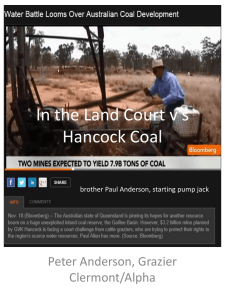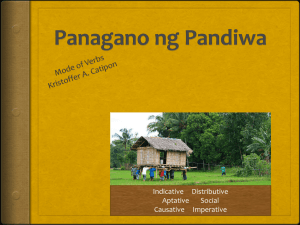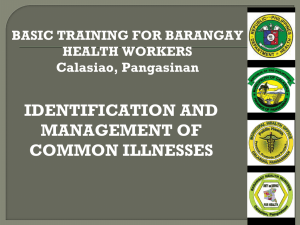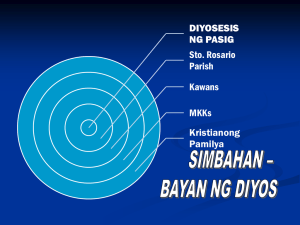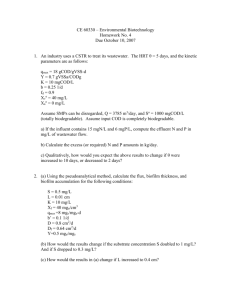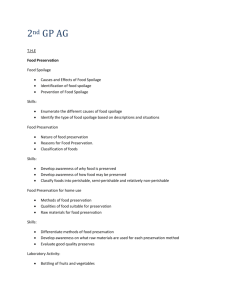Nauunawaan ng mag- aaral ang… Ang mag
advertisement
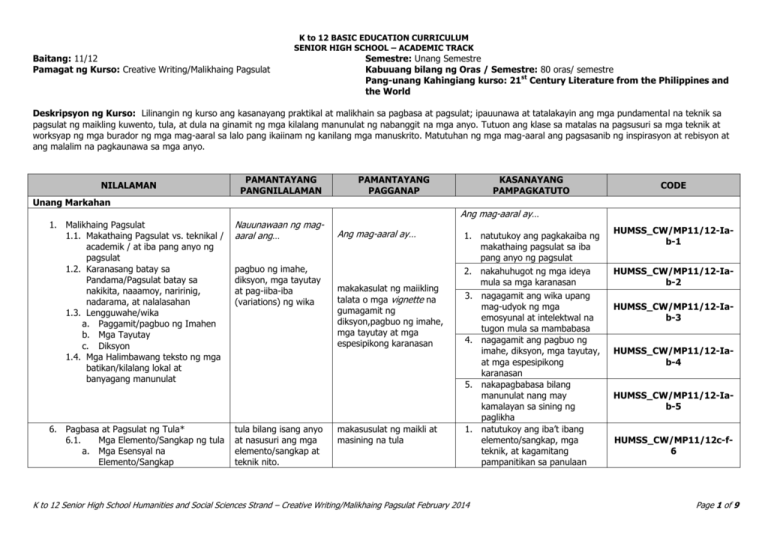
Baitang: 11/12 Pamagat ng Kurso: Creative Writing/Malikhaing Pagsulat K to 12 BASIC EDUCATION CURRICULUM SENIOR HIGH SCHOOL – ACADEMIC TRACK Semestre: Unang Semestre Kabuuang bilang ng Oras / Semestre: 80 oras/ semestre Pang-unang Kahingiang kurso: 21st Century Literature from the Philippines and the World Deskripsyon ng Kurso: Lilinangin ng kurso ang kasanayang praktikal at malikhain sa pagbasa at pagsulat; ipauunawa at tatalakayin ang mga pundamental na teknik sa pagsulat ng maikling kuwento, tula, at dula na ginamit ng mga kilalang manunulat ng nabanggit na mga anyo. Tutuon ang klase sa matalas na pagsusuri sa mga teknik at worksyap ng mga burador ng mga mag-aaral sa lalo pang ikaiinam ng kanilang mga manuskrito. Matutuhan ng mga mag-aaral ang pagsasanib ng inspirasyon at rebisyon at ang malalim na pagkaunawa sa mga anyo. NILALAMAN PAMANTAYANG PANGNILALAMAN PAMANTAYANG PAGGANAP KASANAYANG PAMPAGKATUTO CODE Unang Markahan 1. Malikhaing Pagsulat 1.1. Makathaing Pagsulat vs. teknikal / academik / at iba pang anyo ng pagsulat 1.2. Karanasang batay sa Pandama/Pagsulat batay sa nakikita, naaamoy, naririnig, nadarama, at nalalasahan 1.3. Lengguwahe/wika a. Paggamit/pagbuo ng Imahen b. Mga Tayutay c. Diksyon 1.4. Mga Halimbawang teksto ng mga batikan/kilalang lokal at banyagang manunulat 6. Pagbasa at Pagsulat ng Tula* 6.1. Mga Elemento/Sangkap ng tula a. Mga Esensyal na Elemento/Sangkap Nauunawaan ng magaaral ang… pagbuo ng imahe, diksyon, mga tayutay at pag-iiba-iba (variations) ng wika tula bilang isang anyo at nasusuri ang mga elemento/sangkap at teknik nito. Ang mag-aaral ay… Ang mag-aaral ay… makakasulat ng maiikling talata o mga vignette na gumagamit ng diksyon,pagbuo ng imahe, mga tayutay at mga espesipikong karanasan makasusulat ng maikli at masining na tula 1. natutukoy ang pagkakaiba ng makathaing pagsulat sa iba pang anyo ng pagsulat 2. nakahuhugot ng mga ideya mula sa mga karanasan 3. nagagamit ang wika upang mag-udyok ng mga emosyunal at intelektwal na tugon mula sa mambabasa 4. nagagamit ang pagbuo ng imahe, diksyon, mga tayutay, at mga espesipikong karanasan 5. nakapagbabasa bilang manunulat nang may kamalayan sa sining ng paglikha 1. natutukoy ang iba’t ibang elemento/sangkap, mga teknik, at kagamitang pampanitikan sa panulaan K to 12 Senior High School Humanities and Social Sciences Strand – Creative Writing/Malikhaing Pagsulat February 2014 HUMSS_CW/MP11/12-Iab-1 HUMSS_CW/MP11/12-Iab-2 HUMSS_CW/MP11/12-Iab-3 HUMSS_CW/MP11/12-Iab-4 HUMSS_CW/MP11/12-Iab-5 HUMSS_CW/MP11/12c-f6 Page 1 of 9 K to 12 BASIC EDUCATION CURRICULUM SENIOR HIGH SCHOOL – ACADEMIC TRACK NILALAMAN PAMANTAYANG PANGNILALAMAN PAMANTAYANG PAGGANAP a.1. Tema a.2. Tono b. Mga Elemento ng mga Tiyak na Anyo b.1. Kumbensyunal na Tula (halimbawa: maiikling tulang Tagalog tulad ng tanaga at diona; haiku; soneto) -rima/tugma at medida/sukat -metapora b.2. Malayang Taludturan -the line and line break -enjambments -metapora c. Iba pang eksperimental na teksto c.1. typography c.2. genre-crossing texts (e.g. prose poem, performance poetry, atbp.) d. Tono 2.3. Teknik at kagamitang pampanitikan (Mga halimbawang teksto ng mga batikan/kilalang lokal at banyagang makata) 3. Pagbasa at Pagsulat ng Maikling Kuwento* 3.1. Mga Elemento/Sangkap ng Maikling Kuwento a. Tauhan b. Punto de bista b.1. unang panauhan/1st- person POV (major, minor, or bystander) b.2. pangalawang panauhan/ 2nd-person POV b.3. pangatlong panauhan/ maikling kuwento bilang isang anyo at nasusuri ang mga elemento/sangkap at teknik nito makasusulat ng isang tampok na eksena/tagpo para sa isang maikling kuwento KASANAYANG PAMPAGKATUTO CODE 2. natutukoy ang mga espesipikong anyo at kumbensyon sa panulaan HUMSS_CW/MP11/12c-f7 3. nakagagamit ng piling mga sangkap sa panulaan sa maiikling ehersisyo ng pagsulat HUMSS_CW/MP11/12c-f8 4. nakatutuklas ng mga teknik sa pagsulat ng tula HUMSS_CW/MP11/12c-f9 5. nakasusulat ng tula na gumagamit ng iba’t ibang sangkap,mga teknik, at kagamitang pampanitikan HUMSS_CW/MP11/12c-f10 1. natutukoy ang iba’t ibang elemento/sangkap at kagamitang pampanitikan sa maikling kuwento K to 12 Senior High School Humanities and Social Sciences Strand – Creative Writing/Malikhaing Pagsulat February 2014 HUMSS_CW/MPIg-i-11 Page 2 of 9 K to 12 BASIC EDUCATION CURRICULUM SENIOR HIGH SCHOOL – ACADEMIC TRACK NILALAMAN c. milieu d.3. sensibilidad na tumutungo sa mga espesipikong moda (modes) e. Tunggalian f. Ironiya f.1. berbal f.2. sitwasyunal f.3. dramatik g. Tema f.1. aral f.2. dramatic premise f.3. pag-unawa sa tunay na kalikasan ng isang sitwasyon (insight) 3.2. Mga Teknik at Kagamitang Pampanitikan a. Panagano (Mood) /tono b. Pahiwatig ng magaganap 3.3. PAMANTAYANG PAGGANAP KASANAYANG PAMPAGKATUTO CODE 3rd-person POV (objective, limited omniscient, omniscient) Banghay c.1. linyar c.2. modyular/episodik c.3. mga tradisyunal na bahagi: eksposisyon, papataas na antas ng aksyon, kasudulan/rurok, kalakasan, resolusyon (denouement) d. Tagpuan at kaligiran d.1. panahon at lugar d.2. kultural, sosyolohikal, pulitikal, religihiyoso, atbp. c. PAMANTAYANG PANGNILALAMAN (Foreshadowing) 2. natutukoy ang iba’t ibang moda (modes) ng maikling kuwento HUMSS_CW/MPIg-i-12 3. nakasusulat ng dyornal at maiikling ehersisyo na gumagamit ng mga pangunahing elemento ng maikling kuwento HUMSS_CW/MPIg-i-13 4. nakasusulat ng isang maikling eksena/tagpo na gumagamit ng iba’t ibang elemento, teknik at kagamitang pampanitikan HUMSS_CW/MPIg-i-14 Simbolismo at motif Mga halimbawang teksto ng mga batikan/kilalang lokal at banyagang kuwentista K to 12 Senior High School Humanities and Social Sciences Strand – Creative Writing/Malikhaing Pagsulat February 2014 Page 3 of 9 K to 12 BASIC EDUCATION CURRICULUM SENIOR HIGH SCHOOL – ACADEMIC TRACK NILALAMAN IKALAWANG MARKAHAN 4. Pagbasa at Pagsulat ng Dula (iisahingyugto) * Mga Elemento/Sangkap ng Dula a. Tauhan b. Tagpuan c. Banghay d. Diyalogo 4.1. Mga Teknik at Kagamitang Pampanitikan a. Intertekstwalidad b. Konseptwalisasyon ng Metodo o Paraan 4.2. Mga Halimbawang teksto ng mga batikan/kilalang lokal o banyagang mandudula 5. Ang malikhaing akda sa pampanitikan at /o sosyo-pulitikal na konteksto PAMANTAYANG PANGNILALAMAN PAMANTAYANG PAGGANAP KASANAYANG PAMPAGKATUTO CODE dula bilang isang anyo at nasusuri ang mga elemento/sangkap nito makabubuo ng isang tagpo/eksena para sa isang iisahing-yugtong dula na maisasatanghalan 1. natutukoy ang iba’t ibang elemento/sangkap, teknik at kagamitang pampanitikan ng dula HUMSS_CW/MPIj-IIc-15 2. nauunawaan ang intertekstwalidad bilang isang teknik ng dula HUMSS_CW/MPIj-IIc-16 iba’t ibang oryentasyon ng malikhaing pagsulat makabubuo ng craft essay ukol sa personal at malikhaing proseso na malay na gumagamit ng piniling oryentasyon sa malikhaing pagsulat 3. nakabubuo ng tauhan/tagpuan/bang-hay para sa iisahing- yugtong dula 4. nagagamit ang iba’t ibang metodo o paraan sa pagtatanghal nang nagsasaalang-alang sa binubuong iskrip 5. nakasusulat ng maiikling ehersisyo patungkol sa tauhan, diyalogo, banghay, at iba pang sangkap/elemento ng dula 6. nakasusulat ng isang tagpo/eksena para sa iisahing-yugtong dula na gumagamit ng iba’t ibang elemento/sangkap, teknik, at mga kagamitang pampanitikan 1. nailulugar ang malikhaing teksto sa pampanitikan at /o sosyo-pulitikal na konteksto 2. naipapamalas ang kamalayan at sensitibidad sa iba’t ibang oryentasyon ng malikhaing pagsulat K to 12 Senior High School Humanities and Social Sciences Strand – Creative Writing/Malikhaing Pagsulat February 2014 HUMSS_CW/MPIj-IIc-17 HUMSS_CW/MPIjc-18 HUMSS_CW/MPIj-IIc-19 HUMSS_CW/MPIj-IIc-20 HUMSS_CW/MPIIc-f-21 HUMSS_CW/MPIIc-f-22 Page 4 of 9 K to 12 BASIC EDUCATION CURRICULUM SENIOR HIGH SCHOOL – ACADEMIC TRACK NILALAMAN PAMANTAYANG PANGNILALAMAN PAMANTAYANG PAGGANAP KASANAYANG PAMPAGKATUTO 3. nakasusulat ng craft essay 6. Pinal na Gawain/Final output** Maaaring pumili ang magaaral ng alinman sa sumusunod: 1. Pagdidisenyo ng pangkatang blog para sa tula at maikling kuwento 2. Bumuo ng antolohiya/koleksyo n ng mga tula/isang maikling kuwento o iskrip para sa iisahingyugtong dula na maitatanghal 3. Bumuo ng hypertext literature 1. nakabubuo ng pangkatang blog para sa tula at/o maikling kuwento na gumagamit ng angkop na ICT/mga anyong multimedia 2. nagagamit ang iba’t ibang moda ng publishing media para sa mga manuskrito 3. nauunawaan ang posibilidad ng mga intertekstwal na anyo 4. nakasusulat ng antololohiya/koleksyonng mga tula, isang maikling kuwento, o iskrip para sa iisahing- yugtong dula CODE HUMSS_CW/MPIIc-f-23 HUMSS_CW/MPIIg-j-24 HUMSS_CW/MPIIg-j-25 HUMSS_CW/MPIIg-j-26 HUMSS_CW/MPIIg-j-27 *Para sa tula, maikling kuwento, at dula, iminumungkahi ang worksyap. **Mahalaga ang pagkikritika sa sariling likha/akda ng mag-aaral, gayundin ang pagkikritika ng kamag-aral para sa rebisyon na kailangan naman para sa pinal na output. Paalala: Iangkop ang bilang ng oras/panahon sa mga aralin/paksa ayon sa kapasidad ng mag-aaral. K to 12 Senior High School Humanities and Social Sciences Strand – Creative Writing/Malikhaing Pagsulat February 2014 Page 5 of 9 K to 12 BASIC EDUCATION CURRICULUM SENIOR HIGH SCHOOL – ACADEMIC TRACK GLOSSARY Blog Craft essay Coming-of-age story Diction Figure of speech Foreshadowing Hyperpoetry Image A web log: A website containing short articles called posts that are changed regularly. Some are written by one person expressing his/her own opinions, interest, and experiences, while others are written by many different people. An essay that discusses matters of creative construction that may include reflections on writing strategies, genre elements, and contextual influences. A type of story in which the protagonist is initiated into adulthood through knowledge, experience, or both, often by a process of disillusionment. Understanding comes after the dropping of preconceptions, a destruction of a false sense of security, or in some way the loss of innocence. Some of the shifts that take place are the following: ignorance to knowledge, innocence to experience, false view of world to correct view, idealism to realism, and immature responses to mature responses. (Literary Terms list EETT.pdf, from www.schenectady.k12.ny.us/.../literacyterms/Literary%20Terms%20list%20...); novel in which an adolescent protagonist comes to adulthood by a process of experience and disillusionment. This character loses his or her innocence, discovers that previous preconceptions are false, or has the security of childhood torn away, but usually matures and strengthens by this process. Examples include Wieland's Agathon, Herman Raucher's Summer of '42, Ray Bradbury's Dandelion Wine, Joyce's A Portrait of the Artist as a Young Man, and Jane Austen's Northanger Abbey. The most famous examples are in German, in which a tale in the genre is called a Bildungsroman or a Erziehungsroman. Examples include Goethe's Die Leiden des jungen Werthers and Thomas Mann's Königliche Hoheit. (http://web.cn.edu/kwheeler/lit_terms_C.html) The selection of words in a literary work. A work's diction forms one of its centrally important literary elements, as writers use words to convey action, reveal character, imply attitudes, identify themes, and suggest values. We can speak of the diction particular to a character, as in Iago's and Desdemona's very different ways of speaking in Othello. We can also refer to a poet's diction as represented over the body of his or her work, as in Donne's or Hughes's diction. (http://highered.mcgraw-hill.com/sites/0072405228/student_view0/poetic_glossary.html) Also known as figurative language, it creates figures (pictures) in the mind of the reader or listener. These pictures help convey the meaning and more vividly than words alone. We use figures of speech in “figurative language” to add colour and interest, and awaken the imagination. Figurative language is everywhere, from classical works like Shakespeare’s and the Bible, to everyday speech, pop music, and television commercials. Figurative language means something different from (and usually more than) what it says on the surface. The presentation of details, characters, or incidents in a narrative in such a way that later events are prepared for (or "shadowed forth"). (http://grammar.about.com/od/fh/g/foreshadowingterm.htm) A form of digital poetry that uses links using hypertext mark-up. It is a very visual form, and is related to hypertext fiction and visual arts. The links mean that a hypertext poem has no set order, the poem moving or being generated in response to the links that the reader/user chooses. It can either involve set words, phrases, lines, etc. that are presented in variable order, but sit on the page in the same way traditional poetry does, or it can contain parts of the poem that move and/or mutate. It is usually found online, though CDROM and diskette versions exist. The earliest date to no later than mid-1980s. A concrete representation of a sense impression, a feeling, or an idea. Imagery refers to the pattern of related details in a work. In some works one image predominates either by recurring throughout the work or by appearing at a critical point in the plot. Often, writers use multiple images throughout a work to suggest states of feeling and to convey implications of thought and action. Some modern poets, such as Ezra Pound and William Carlos Williams, write poems that lack discursive explanation entirely and include only images. (http://highered.mcgraw-hill.com/sites/0072405228/student_view0/poetic_glossary.html) K to 12 Senior High School Humanities and Social Sciences Strand – Creative Writing/Malikhaing Pagsulat February 2014 Page 6 of 9 K to 12 BASIC EDUCATION CURRICULUM SENIOR HIGH SCHOOL – ACADEMIC TRACK GLOSSARY Imaginative writing Intertextuality Irony Literary device Literary elements Literary genre Literary techniques Motif Sensory experience A mode of writing characterized by inventiveness of situation, perspective, or story, and distinguished from other modes such as expository and persuasive writing (http://ccat.sas.upenn.edu/~haroldfs/popcult/wrtmodes.htm). The term is often used synonymously with "creative writing". The complex interrelationship between a text and other texts taken as basic to the creation or interpretation of the text There are several types of irony in literature. Three main types are verbal irony, dramatic irony, and situational irony. Verbal irony is the contrast between what is said and what is meant: In other words, sarcasm. Dramatic irony is the contrast between what the character thinks to be true and what we (the reader) know to be true. Sometimes as we read we are placed in the position of knowing more than what one character knows. Because we know something the character does not, we read to discover how the character will react when he or she learns the truth of the situation. Situational irony is the most common in literature. It is the contrast between what happens and what was expected (or what would seem appropriate). (http://hrsbstaff.ednet.ns.ca/engramja/litdevic.html) A literary or linguistic technique that produces a specific effect, esp. a figure of speech, narrative style, or plot mechanism. (http://dictionary.reference.com/browse/literary+device) Refers to particular identifiable characteristics of a whole text. They are not “used”, per se, by authors; they represent the elements of storytelling that are common to all literary and narrative forms. For example, every story has a theme, every story has a setting, every story has a conflict, every story is written from a particular point of view, etc. in order to be discussed legitimately as part of a textual analysis, literary elements must be specifically identified for that particular text. A category of literary composition; genres may be determined by literary techniques, tone, content, or even (as in the case of fiction) length. The distinctions between genres and categories are flexible and loosely defined, often with subgroups. The most general genres in literature are (in loose chronological order) epic, tragedy, comedy, and creative nonfiction. They can all be in the form of prose or poetry. Additionally, genres such as satire, allegory, or pastoral might appear in any of the above, not only as a sub-genre, but as a mixture of genres. Finally, they are defined by the general cultural movement of the historical period in which they were composed. Genre should not be confused with age categories, by which literature may be classified as either adult, young-adult, or children’s. They also must not be confused with format, such as graphic novel or picture book. Refers to any specific, deliberate constructions, or choices of language that an author uses to convey meaning in particular way. An author’s use of a literary technique usually occurs with a single word or phrase, or a particular group of words or phrases, at one single point in a text. Unlike literary elements, literary techniques are not necessarily present in every text; they represent deliberate choices by individual authors. A recurring object, concept, or structure in a work of literature. A motif may also be two contrasting elements in a work, such as good and evil. In the Book of Genesis, we see the motif of separation again and again throughout the story. In the very first chapter, God separates the light from the darkness. Abraham and his descendants are separated from the rest of the nation as God's chosen people. Joseph is separated from his brothers in order that life might be preserved. Another motif is water, seen in Genesis as a means of destroying the wicked, and in Matthew as a means of remitting sins by the employment of baptism. Other motifs in Genesis and Matthew include blood sacrifices, fire, lambs, and goats. A motif is important because it allows one to see main points and themes that the author is trying to express, so that one might be able to interpret the work more accurately. (http://www2.uncp.edu/home/canada/work/allam/general/glossary.htm#m) The apprehension of an object, thought, or emotion through the senses; active participation in events or activities, leading to the accumulation of knowledge or skill. (http://www.thefreedictionary.com/experience) K to 12 Senior High School Humanities and Social Sciences Strand – Creative Writing/Malikhaing Pagsulat February 2014 Page 7 of 9 K to 12 BASIC EDUCATION CURRICULUM SENIOR HIGH SCHOOL – ACADEMIC TRACK GLOSSARY Symbolism Theme Typography Vignette A character, an action, a setting, or an object representing something else can be a symbol. Most often, the symbol in a story is an object that represents its owner’s character or situation, or both. For example, a secluded, near-empty apartment might represent the alienation and emotional emptiness of the tenant. Symbols are usually recognizable by the amount of emphasis they receive. Objects intended to be viewed as symbolic may be described in detail, be included in the title, be referred to frequently, or emphasized at the beginning or ending of the story. When we recognize a symbol and understand its meaning or meanings, we see more clearly what the writer chose to emphasize. (http://hrsbstaff.ednet.ns.ca/engramja/litdevic.html) Assertion or argument that the literary work makes. The general character or appearance of printed matter. (http://dictionary.reference.com/browse/typography) Literally "little vine" in French; a short composition showing considerable skill, especially such a composition designed with little or no plot or larger narrative structure. Vignettes are often descriptive or evocative in their nature. An example would be the brief narratives appearing in Sandra Cisneros's short stories. More loosely, vignettes might be descriptive passages within a larger work, such as Virginia Woolf's "Kew Gardens", or Faulkner's descriptions of horses and landscapes in The Hamlet. The term “vignette” originally comes from a decorative device appearing on a title page or at the opening chapters. Conventionally, nineteenth-century printers depicted small looping vines here, loosely reminiscent of the vine work in medieval manuscripts. (http://web.cn.edu/kwheeler/lit_terms_V.html) K to 12 Senior High School Humanities and Social Sciences Strand – Creative Writing/Malikhaing Pagsulat February 2014 Page 8 of 9 K to 12 BASIC EDUCATION CURRICULUM SENIOR HIGH SCHOOL – ACADEMIC TRACK CODE BOOK LEGEND SAMPLE CODE: HUMSS_CW/MP12-Ia-b-1 LEGEND SAMPLE Track/ Strand Humanities and Social Sciences Strand underscore_ First Entry Track/ Strand Subject Creative Writing Grade Level 11/12 HUMSS_CW/MP11/12 Roman Numeral *Zero if no specific quarter Quarter Quarter I Lowercase Letter *Put a hyphen (-) in between letters to indicate more than a specific week Week Week a-j - Arabic Number Competency Differentiate imaginative writing from among other forms of writing K to 12 Senior High School Humanities and Social Sciences Strand – Creative Writing/Malikhaing Pagsulat February 2014 5 Page 9 of 9
